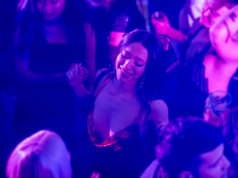Larry Gagosian is probably why contemporary art is so misunderstood and the art-world establishment loathed by everyone who’s not part of it, all nine zillion of us non-billionaires.
Gagosian represents nearly 80 artists and estates, all Modernists or contemporary artists, and all mostly titans, including Picasso, Alberto Giacometti, Cy Twombly, Richard Serra, Jeff Koons, Damien Hirst, and Ed Ruscha (whose exhibit at the Modern Art Museum of Fort Worth, Road Tested, is worth close inspection and will be coming down next week). Gagosian, with galleries in Athens, Geneva, Hong Kong, London, and Rome, among other hot spots –– he has 11 in total worldwide –– reportedly sells in excess of $1 billion annually. The auction house Sotheby’s, by comparison, last year sold merely $870 million in contemporary art.
Gagosian’s empire, according to The Wall Street Journal, is the first of its kind in history, and now with 11 galleries, Larry “needs to supply about 60 distinct shows a year with fresh art.” He also needs to sell! sell! sell! what he’s hanging, and of all the myriad forms of visual art, contemporary art is easily the most iffy aesthetically and financially –– its conceptual underpinnings and heavy reliance on scholarship, traits much less easily qualitative than sweat equity and history, create doubts in the hearts and minds of (most) collectors, who are being asked to plop down millions of dollars. Work by some of Gagosian’s trendiest artists, especially British conceptualist Hirst, has not been performing well at auction over the past couple of years.
For some collectors, however, aesthetics is far from the primary reason to initiate a business transaction with L-Gag.
From the WSJ: “Private dealer Richard Polsky says that in many cases, when collectors buy from Mr. Gagosian, what they’re really buying is Mr. Gagosian’s cachet: ‘You cannot underestimate the egos of the people who buy from Gagosian. Most would rather overpay to be part of his world, and he counts on that mystique to draw clients to him.”
Dallas collector Howard Rachofsky, a Gagosian client, is Exhibit A: “Sometimes we don’t know if the stuff we’re buying is historically significant,” Rachofsky said, “but because the prices are so high, we need to believe [that stuff is] important.”
Say whaaaaat?!
What happened to having good freaking taste, man?!
I know, I know. I’m so naïve. Art as it exists in the worlds of Gagosian and Rachofsky is as much an investment as, say, stocks or real estate. Still, when buying property, a thoughtful soul normally seeks out the most attractive plot or building, for various reasons, including but not limited to location, condition, and, yes, aesthetics. And as far as I’m concerned, beauty is not in the eye of the beholder. There’s definitely good art and bad art. Do some people have better taste than others? Absolutely. But the people with good taste know they need to refine their palates constantly and, consequently, study, study, study. What, then, explains the popularity of yawners like Hirst and Walter De Maria? Two words: Larry. Gagosian.
And even though Larry recently embarked on an artist/estate-collecting spree, adding John Chamberlain, Andreas Gursky, and James Turrell and the estates of Rauschenberg and painter Kazimir Malevich, don’t bother mailing your slides to the gallery –– Larry generally picks up artists only after they’ve mounted a successful museum show or there’s a spike in their pieces at auction.
What did you expect? Grassroots research? What ancient era are you living in?
33











Larry Larr is following the Frank Artsmarter’s school of Art inflation. The biography of an artist/dealer or the mythology of the work itself is inversely proportional to the “value” of the work of art!!
For more on the illustrious Mr. Artsmarter: https://www.fwweekly.com/index.php?option=com_wordpress&p=5325&Itemid=482